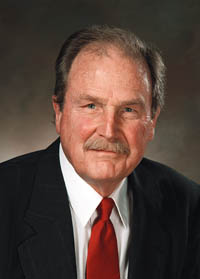
October 11, 1999
Eminent UCSC computer scientist David Huffman dies at age 74
'Huffman Codes' used in fax machines, modems, other applications involving the compression of data
By Tim Stephens and Jim Burns
David A. Huffman, the founding faculty member of the Computer Science Department and a pioneer in the field, died at a local hospital on Thursday, October 7, after a 10-month battle with cancer. He was 74.
 |
| David Huffman Photo: Don Harris |
A memorial service for Huffman is planned, but no details are available at this time.
Huffman is probably best known for the development of the Huffman Coding Procedure, the result of a term paper he wrote while a graduate student at the Massachusetts Institute of Technology (MIT). "Huffman Codes" are used in nearly every application that involves the compression and transmission of digital data, such as fax machines, modems, computer networks, and high-definition television.
Huffman joined the faculty at MIT in 1953. In 1967, he came to UC Santa Cruz as the founding faculty member of the Computer Science Department. He played a major role in the development of the department's academic programs and the hiring of its faculty, and served as chair from 1970 to 1973. He retired in 1994, but remained active until recently as an emeritus professor, teaching information theory and signal analysis courses.
Huffman made important contributions in many different areas, including information theory and coding, signal designs for radar and communications applications, and design procedures for asynchronous logical circuits. As an outgrowth of his work on the mathematical properties of "zero curvature" surfaces, Huffman developed his own techniques for folding paper into unusual sculptured shapes.
Huffman's accomplishments earned him numerous awards and honors. Most recently, he received the 1999 Richard W. Hamming Medal from the Institute of Electrical and Electronics Engineers (IEEE) in recognition of his exceptional contributions to information sciences. He also received the Louis E. Levy Medal of the Franklin Institute for his doctoral thesis on sequential switching circuits, a Distinguished Alumnus Award from Ohio State University, and the W. Wallace McDowell Award. He was a charter recipient of the Computer Pioneer Award from the IEEE Computer Society, and he received a Golden Jubilee Award for Technological Innovation from the IEEE Information Theory Society in 1998.
A native of Ohio, Huffman earned his bachelor's degree in electrical engineering from Ohio State University at the age of 18. He then served in the U.S. Navy as a radar maintenance officer on a destroyer that helped to clear mines in Japanese and Chinese waters after World War II. He subsequently earned his master's degree from Ohio State and his doctorate from MIT, also in electrical engineering.
David Huffman is survived by his wife, Marilyn Huffman, of Santa Cruz; his former wife, Jane Ayres Huffman; their two daughters, Elise and Linda Huffman, both of Santa Cruz; their son, Stephen Huffman, of Santa Cruz; a son-in-law, Jeff Grubb, of Santa Cruz; a stepdaughter, Marti Homer Kehlet, of Sacramento, her husband, Daret, and their daughter, Karsen; a stepson, Darin Homer of Prunedale, his wife, Jane, and their son, Ryan; and a brother, Donald Huffman, of Westerville, Ohio, his wife, Jean, and their family.
At the family's request, contributions in David Huffman's name may be made to the Hospice Caring Project of Santa Cruz County or the American Cancer Society, Santa Cruz Chapter.